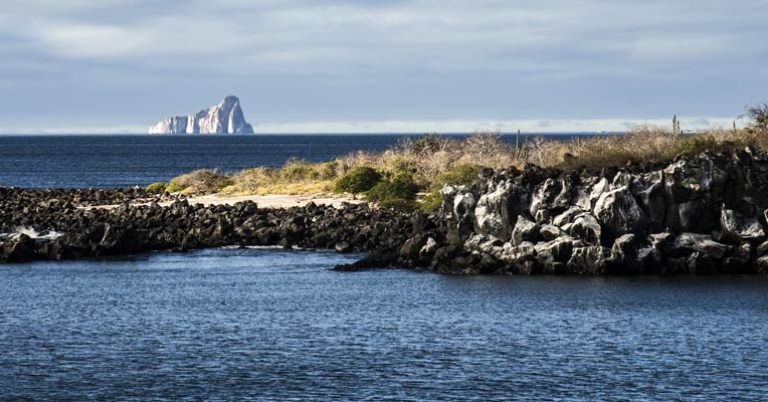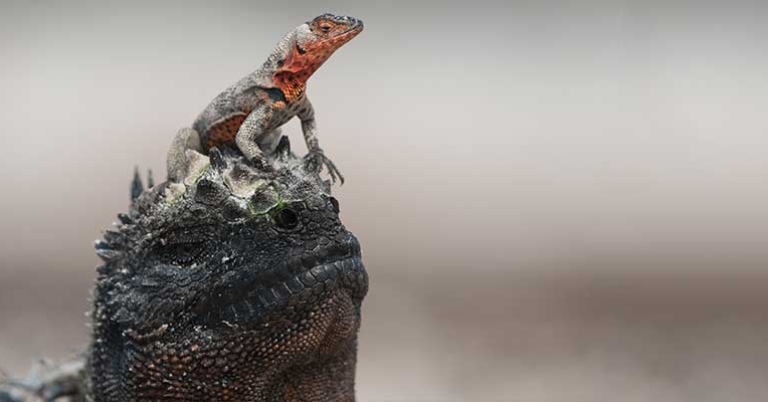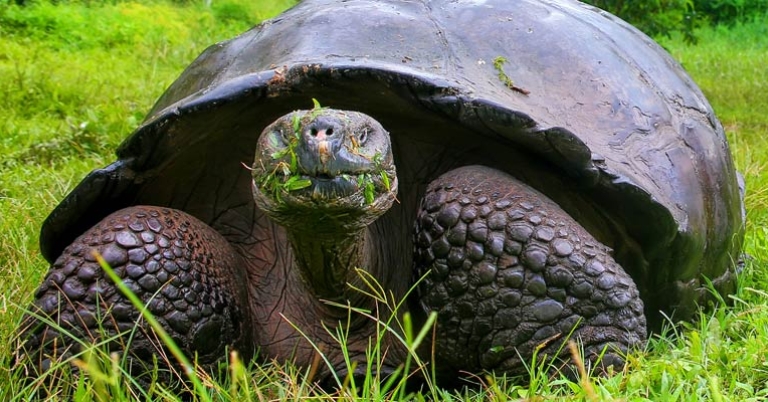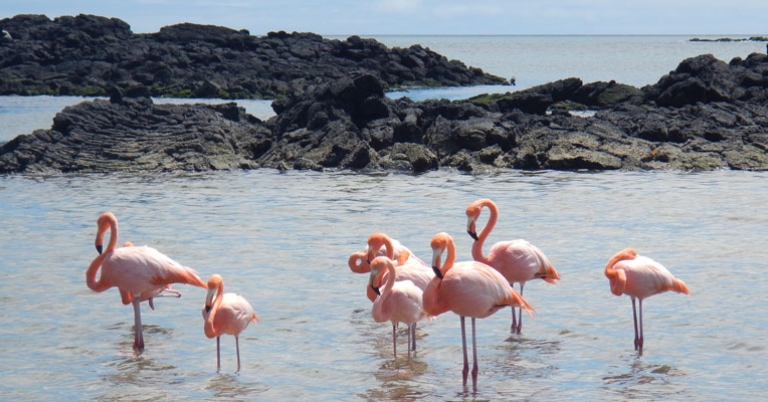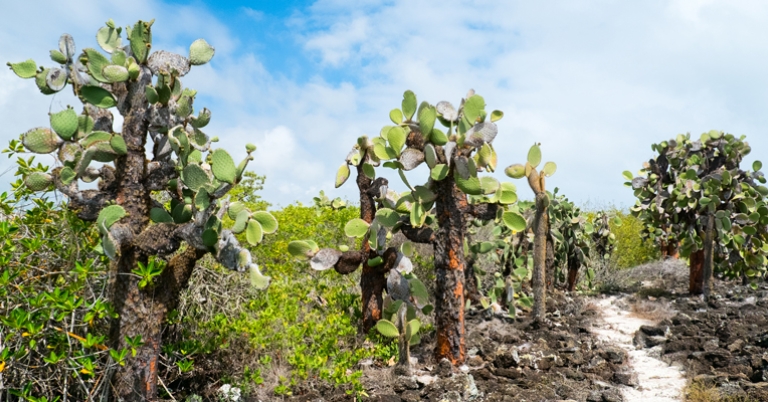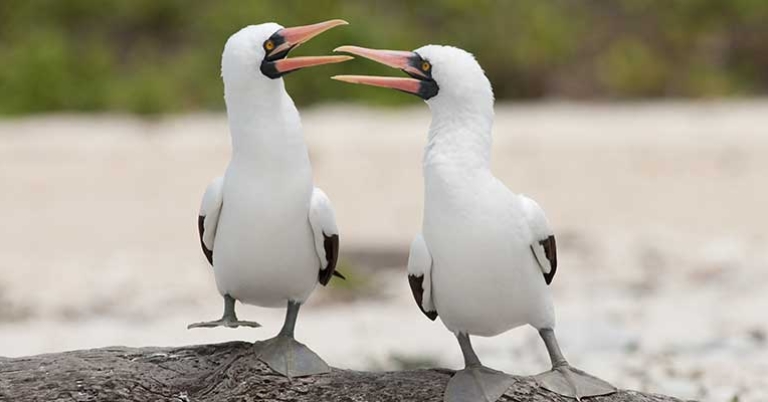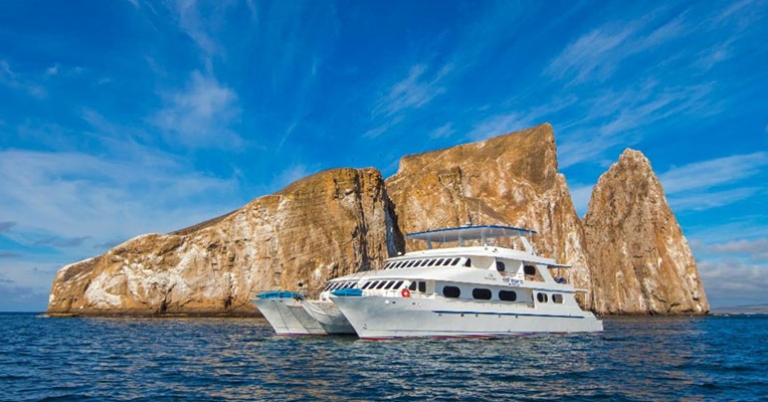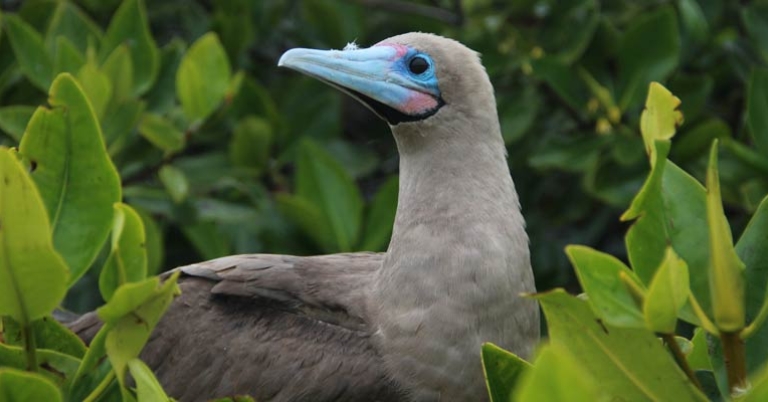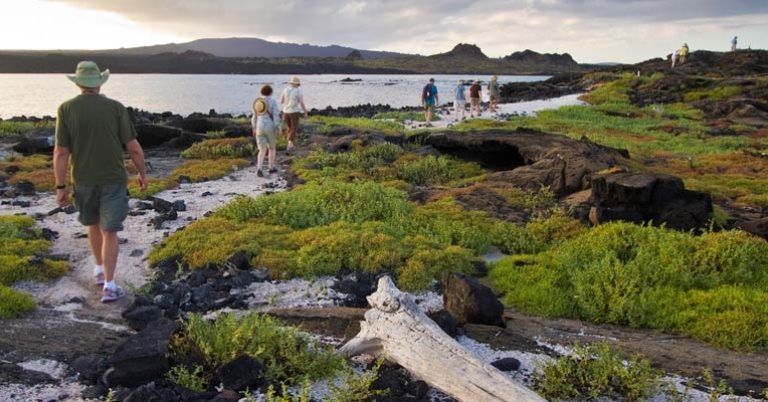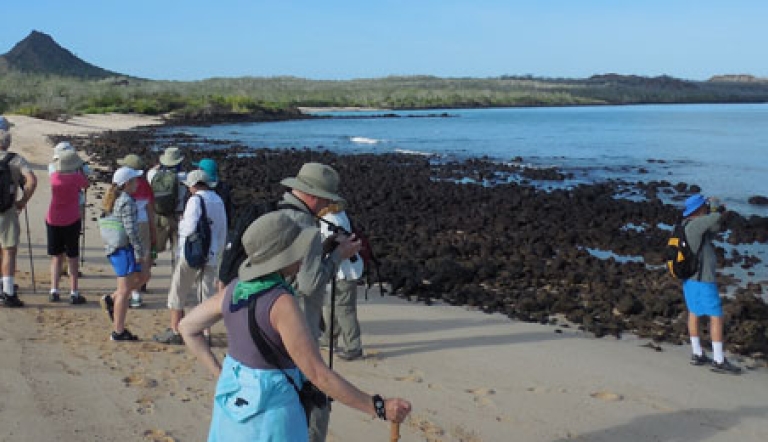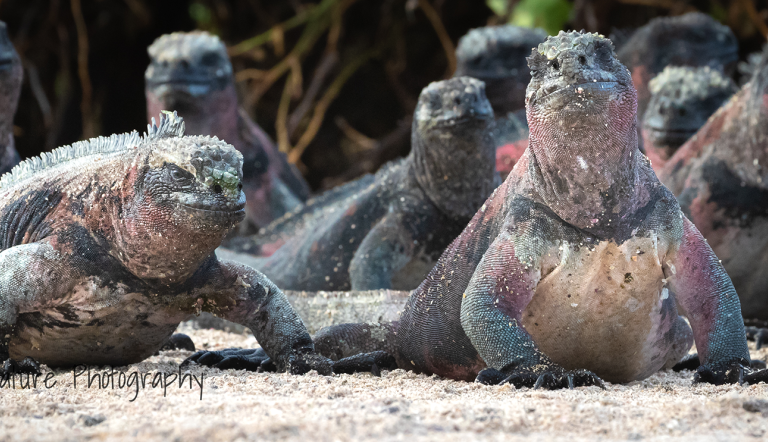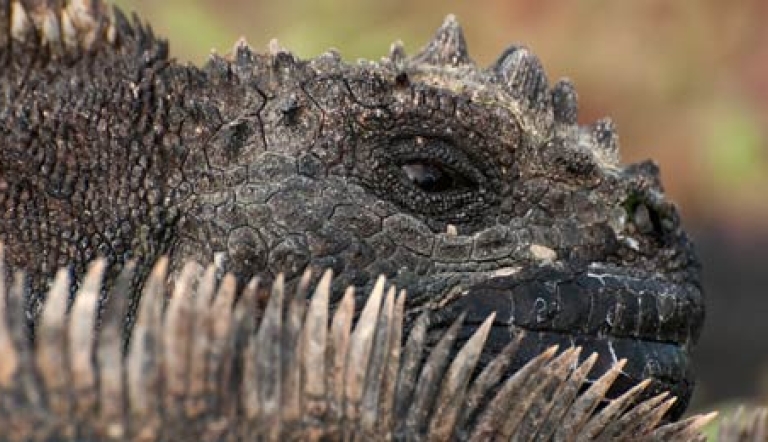Galápagos Islands | Cruising the Eastern Route aboard Tip Top II
About this trip
 The Galápagos Islands have long intrigued outsiders with their endemic flora and fauna, geological activity, and unusual terrain. Join the Delaware Nature Society on this cruise expedition for a front-row seat to explore the eastern islands. Stunning formations like saw-toothed Kicker Rock and Cerro Brujo, volcanic calderas, sandy beaches, and flamingo lagoons play host to iconic wildlife like Red- and Blue-footed Boobies, marine turtles, giant tortoises, iguanas, and more. With no fear of human predation, many creatures can be approached at close range; you can even swim with the sea lions. Also examine the archipelago’s dramatic human history, from 18th century whalers and pirates to its role in World War II and present-day inhabitants.
The Galápagos Islands have long intrigued outsiders with their endemic flora and fauna, geological activity, and unusual terrain. Join the Delaware Nature Society on this cruise expedition for a front-row seat to explore the eastern islands. Stunning formations like saw-toothed Kicker Rock and Cerro Brujo, volcanic calderas, sandy beaches, and flamingo lagoons play host to iconic wildlife like Red- and Blue-footed Boobies, marine turtles, giant tortoises, iguanas, and more. With no fear of human predation, many creatures can be approached at close range; you can even swim with the sea lions. Also examine the archipelago’s dramatic human history, from 18th century whalers and pirates to its role in World War II and present-day inhabitants.
PLEASE NOTE: This itinerary is subject to change without prior notice due to unforeseen circumstances (e.g. weather) or at the discretion of the captain, guide, or the Galápagos National Park.
OPTIONAL PRE-TRIP EXTENSION: Kick off your Ecuador experience with "Nature & Wildlife in the Andes," June 17 - 21, 2023.
Highlights
- Explore the Opuntia cactus forest on South Plaza Island and observe colonies of land iguanas.
- Learn about important conservation efforts at the Charles Darwin Research Station’s tortoise breeding center.
- Walk along the lava beds of Española Island, one of the best places in the world to see the Waved Albatross.
- Come face-to-face with sea lions, turtles, sharks, rays, and colorful fish during several snorkeling excursions.
- Take part in a centuries-old tradition by leaving a postcard in the barrel at Post Office Bay.
Meet your leaders
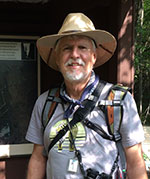 Jim White
Jim White
Jim White has worked at Delaware Nature Society since 1982 where he has directed the Delaware Nature Society’s land and biodiversity management program. A native Delawarean, he attended the University of Delaware. Jim is dedicated to the protection and management of Delaware’s native species and the habitats where they live. His primary natural history interests include insects, amphibians, reptiles and birds. He teaches herpetology at University of Delaware and with his wife has published a field guide to the Amphibians and Reptiles of the Delmarva Peninsula. He has written extensively on Delaware’s biodiversity and speaks regularly on the topic. Jim also leads natural history trips to many natural areas in the US and in Central and South America including the Galapagos Islands.
 Joe Sebastiani
Joe Sebastiani
Joe Sebastiani is the Director of Adult Engagement with the Delaware Nature Society (DNS), where he has worked since 1998. He specializes in leading adult nature field excursions and classes, including trips to such far-flung places as Cuba, Trinidad, Costa Rica, Ecuador, Brazil, and Mexico, Arizona, Texas, and Nebraska. Joe is a self-taught naturalist, has a degree in Environmental Resource Management from Penn State, and a Master’s in Education from West Chester University. He is a past President of the Delaware Ornithological Society and volunteers for Cornell Lab of Ornithology as the Delaware eBird data reviewer.
$6,195
Per person
About this price
Land cost only. Does not include round-trip airfare to and from destination.
What makes us different
Rich content
Carbon offsetting
Wildlife up-close
Service anytime
Cultural Discovery
Support local communities
Daily Itinerary
Print ItineraryQuito
Quito
Galápagos
Galápagos
Galápagos
Galápagos
Galápagos
Galápagos
Galápagos
Quito
Quito
Pricing
Print Pricing$6,195
Per person
About this price
Land cost only. Does not include round-trip airfare to and from destination.
What's Included
- Activities and meals as mentioned in itinerary
- Arrival and departure transfers based on individual flight schedules
- Bottled water or water refill station during transfers
- Carbon Offset
- Full time guide per region for the duration of your program
- Galapagos National Park fees
- INGALA card
- Internal flights relevant to itinerary
- Non alcoholic beverage with meals
- Snorkel gear
What's Not Included
- International airfare
- Items of personal nature
- Tips
- Travel Insurance
Pricing Details
A $1000 per person deposit and enrollment form is due to hold your space on this trip. This deposit is refundable 180 days prior to departure excluding a $200 cancellation fee. Cancellations after this date are non refundable.
Please note: Your participation as a traveler indicates acceptance of Holbrook Travel’s Covid-19 protocols in place at time of travel.
Holbrook Travel strongly recommends the purchase of travel insurance for medical emergencies while traveling and to protect your investment. Please note the purchase of Cancel for Any Reason Coverage or to exclude pre-existing conditions with Trip Cancellation coverage may require policy purchase within 10-14 days of your initial deposit, depending upon the provider.
Final payment due date: March 21, 2023
Travel Info
Print Travel InfoEntry & Exit Requirements
U.S. and Canadian citizens must have a valid passport to enter Ecuador. Passports must be valid for at least six months after the date of departure.
For visits fewer than 90 days, visas will be issued upon arrival in Ecuador. Tourists may be required to provide evidence of return or onwards travel.
If you are not traveling with a U.S. passport, please check with the Embassy of Ecuador for the requirements based on your nationality.
Health Information
IMMUNIZATIONS
The Centers for Disease Control recommends that all travelers be up to date on routine vaccinations such as measles-mumps-rubella (MMR) vaccine, diphtheria-pertussis-tetanus vaccine, varicella (chicken pox) vaccine, and your yearly flu shot before every trip.
There are no vaccinations required for entry into Ecuador (unless you are traveling from Brazil, Democratic Republic of the Congo, or Uganda, in which case proof of yellow fever vaccine is required).
Some physicians recommend that travelers get hepatitis A and typhoid vaccines before visiting Ecuador.
Please consult your physician for additional information and recommendations based on your individual circumstances.
MALARIA
Malaria is not known to be present in Guayaquil or Quito or in the Galápagos Islands. According to the CDC, the estimated relative risk of malaria for U.S. travelers in Ecuador is low. If you are concerned about malaria prevention, please consult your physician.
Dengue Fever & Other Insect-borne Illnesses
Locally transmitted cases of dengue fever have been reported in Ecuador. Local transmission means that mosquitoes in the area have been infected with dengue and are spreading it to people. In addition, locally transmitted cases of chikungunya, Zika virus, and other insect-borne illnesses have previously been reported in Ecuador. The CDC recommends that travelers to Ecuador protect themselves against insect bites. As a precaution, the CDC advises women who are pregnant to consider postponing travel to any area where Zika virus transmission is ongoing.
SEA SICKNESS
If you’re prone to feeling queasy, we suggest you consult your physician for advice on the best ways to prevent motion sickness. We recommend that you avoid showering when the boat is in motion and remain cautious of activities while passing through rocky waters.
ALTITUDE SICKNESS
Upon arrival at locations of high elevation, shortness of breath and a pounding heart are normal responses to the lack of oxygen in the air. However, for some visitors, these symptoms can deteriorate into altitude sickness. Headache, extreme tiredness, dizziness, nausea, and loss of appetite are standard symptoms. Staying hydrated and well rested is important to adjust to the altitude. Avoiding heavy, fatty foods and alcohol in the days before arriving to altitude can help. Over-the-counter medications are also available to help prevent or alleviate symptoms. It’s advisable to avoid sleep medications, as they can slow breathing and respiration, which aid in getting the blood oxygenated while sleeping. Participants who take blood pressure medications should discuss this with their doctor as the medication can drop pressure too low at times.
SUN EXPOSURE
The effects of the sun can be damaging to the eyes and skin. Spending time outdoors exposes you to the sun’s harmful ultraviolet (UV) rays, even on cloudy days. To protect yourself from the sun, use a broad spectrum sunscreen of at least SPF 15, protect skin with clothing, wear a wide-brimmed hat and sunglasses, and drink plenty of fluids.
PHYSICAL FITNESS REQUIREMENTS
Visitors to the Galápagos Islands should be in good health and capable of walking over rocky, uneven, and potentially slippery terrain. Regardless of your physical stamina, bringing a walking stick will help maintain your balance.
Resources
Print ResourcesVessels
Video: Galápagos Fitness Information
Video: Snorkeling in the Galapagos
Suggested Packing List
Everyone has personal preferences when it comes to packing; for this reason, the information below is offered as a general guide and not a definitive list. You know yourself best: Use your discretion and pack what you think will serve you, based on your personal preferences and specific itinerary.
You may find many of these items in our Gear Store.
CLOTHING
Casual, comfortable clothing is suitable for most activities. You may wish to bring a slightly nicer outfit or two (eg sundress, polo shirt) if your itinerary includes dinners out or more formal activities.
Bring enough clothing suitable for the length of your program. Pack clothing that can be worn in layers to adapt to weather changes throughout the day.
- A combination of short-sleeved and lightweight, long-sleeved shirts for sun and mosquito protection
- Shorts
- Lightweight, quick-drying long pants for sun and mosquito protection
- Undergarments
- Sleepwear
- Lightweight jacket or sweater/sweatshirt
- 1-2 bathing suit(s)
- Socks
- Shoes – Consider your specific itinerary when choosing footwear. For most programs, you’ll likely want at least one pair of comfortable, closed-toe walking or hiking shoes suitable for forest hikes and walking over cobblestones or other uneven terrain. Sturdier hiking boots may be appropriate for more active itineraries. In addition, many participants opt for a pair of sturdy sport-strap sandals (e.g. Keens, Tevas, or similar) and/or casual flip-flops or sandals. In the Galápagos, a pair of aqua socks, reef walkers, or water shoes is recommended.
- Lightweight rain jacket, hooded poncho, and/or windbreaker
- Visor or wide-brimmed sun hat
- Bandana, scarf, or neck gaiter
- Wetsuit (shorty wetsuits are available to rent, but you may prefer your own)
Personal toiletries
Pack toiletries based on your personal preferences and habits. Below are just a few recommendations to keep in mind.
- Shampoo, conditioner, lotion, deodorant/antiperspirant, etc. – Note: In the Galápagos, biodegradable shampoo and soap are provided onboard the boat; if you wish to bring your own, please make sure they are biodegradable to comply with conservation policies. If possible, avoid strong fragrances if you are sensitive to insect bites.
- Soap and washcloth or a small, quick-drying microfiber towel – Washcloths are not standard in all hotels. If you normally use a washcloth, you may wish to bring one from home.
- Hairbrush, comb, hair ties, shower cap.
- Toothbrush and toothpaste
- Razor
- Ear plugs, especially if you are a light sleeper
- Personal hygiene products
- Insect repellent with DEET or picaridin (see note below about treating clothing with permethrin)
- Reef-safe sunscreen and lip balm with SPF
- Aloe vera gel
- A travel pack of tissues – also useful as napkins or toilet paper if needed
In addition to your personal toiletries, it is useful to pack a small medical kit, which you can easily prepare. Helpful items might include: bandages, antihistamine, a pain reliever, motion sickness and/or altitude sickness medication (if you are prone to either), anti-diarrhea medicine, individually wrapped pre-moistened towelettes and/or hand sanitizer, antibiotic ointment, anti-fungal cream, moleskin for blisters, eye drops, tweezers, a mini sewing kit, and an extra pair of disposable contact lenses or eyeglasses if you wear them.
Days before you leave home, you may wish to consider spraying any clothing, socks, and shoes that will be worn in lowland, tropical sites with the pesticide permethrin to deter biting insects and prevent the spread of disease. A recommended brand is Sawyer. Carefully read all instructions before use. Please note permethrin is highly toxic to cats and fish, and some aerosol products may be harmful to birds. Side effects may include minor itching, burning, or redness. You may want to use a laundry marker to label and keep track of which socks are permethrinized. Only one application per item is necessary; permethrin on treated clothes remains effective through several washings. Permethrin should NOT be applied directly to skin.
MISCELLANEOUS
Remember to pack valuables such as your passport, cash/credit cards, and medications in your carry-on luggage.
- Passport and photocopies of all travel documentation
- Personal insurance card and travel insurance information
- Money – ATM/credit card, traveler's checks, and/or cash; small bills in good condition are recommended
- Prescription medicines (if applicable), with a copy of the prescription
- Yellow fever certificate (if required; only if arriving from a country where yellow fever transmission is a risk)
- Sunglasses with strap
- Small day pack for hikes and excursions
- Flashlight and/or head lamp
- Travel alarm clock or inexpensive waterproof wristwatch with alarm – Not all hotels provide alarm clocks.
- Binoculars with lens cleaner
- Camera and related equipment, such as charger, lenses, and extra memory cards
- Reusable water bottle
- Non-perishable snacks
- Pocket knife or multipurpose tool - Pack in your checked luggage
- Zip-top style bags – useful for packing toiletries, sorting clothing, storing damp or muddy shoes, or as a dry bag for protecting electronics
- Notepad or travel journal and pen
- Music or reading material for down time, long bus drives, or on the airplane, and a portable bright light to read by
- Walking stick with rubber tip (folding or collapsible, for walking on rough and uneven terrain)
- Swim mask/fins (snorkeling equipment is available to rent and often included for most groups)
- A small quantity of laundry detergent if you’ll be washing clothing by hand
- Money belt
- Converter and adapter for electronics
- Chargers for electronics
NOTE: There is a weight limit of 50 lbs. of checked luggage and one carry-on per person for your flight to the Galápagos Islands. Your luggage and/or carry-on may be subject to inspection by the Ecuadorian government in an effort to prevent the introduction of foreign plants and animals to the Galápagos Islands.

Questions
Contact Debbie Jordan at 866-748-6146 or debbie@holbrooktravel.com
